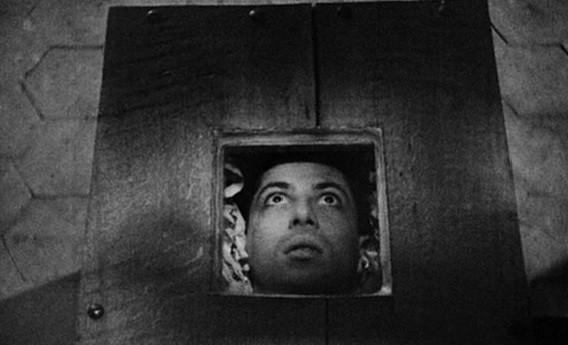Turkeyshoot, or Escape 2000, is one of Brian Trenchard-Smith’s
classic Ozsploitation films, along with Dead-End Drive-In (1989), before he started directing Lifetime movies. Turkeyshoot
is really composed of two parts. The first half is a Cruel, Futuristic Prison
movie, like Fortress (1992) or Riki-Oh (1991), and the second half is a Most Dangerous Game
movie. The staples of both types of movies are hustled through with enthusiasm
and imagination, rarely missing a beat or dragging. There are a few missed
opportunities, but this is balls-out fun with the manic barbarism Trenchard-Smith excelled in.
Steve Railsback and Olivia Hussey are snatched up in what
looks like some sort of middle-class gift shop for the crime of—I dunno.
Railsback pissed someone off and Hussey made the mistake of saying, “Hey, stop
kicking him in the ribs repeatedly.” For her trouble, she awakes in the back of
a truck with a slutty blonde and is carted off to the prison of her dreams.
The prison is, of course, run by a sadistic warden. When are
these prisons not run by sadistic wardens? It’s part of the job description.
Sadistic Warden II, must have advanced experience in sadism or equivalent
education. This fella’s named ‘Thatcher,’ because nobody liked Margaret
Thatcher. His personal goal, he decides, is to break Steve Railsback. Because
Railsback is the peppy, defiant guy we’re going to like. Sadistic wardens hate
those guys. So much of the torture goes to him.
The prison guards are known as ‘toads,’ we learn, and have
all been castrated and/or dismembered because it’s supposed to make them
meaner. Despite this, they repeatedly try to rape Olivia Hussey. She spends a
lot of time running and screaming, when she’s not getting pep-talked by the
blonde and Railsback, or avoiding the co-ed shower room.
The beatings, torture, and attempted rapes are all the usual
fare you expect in the first half of a prison movie. Usually I don’t like the
first half of a prison movie. The whole point of the first half of a prison movie is to make you swell with resentment and splenetic fury as the heroes are helplessly oppressed. It’s just the build up so you can enjoy the hero
kicking the ever-loving crap out of the sadistic warden. With Turkeyshoot, it’s
hit-and-miss. Railsback’s tortures are kinda lame, Hussey is never really in
danger of getting raped, and the worst that happens is a young woman is punched
in the face and another prisoner offers to bury her alive.
The catch with Turkeyshoot is, instead of getting a
second-half of warden-killing, it turns into The Most Dangerous Game (1932). During
the prison scenes, Trenchard-Smith sets the ground for the hunt to come. We meet Thatcher’s rich, powerful
friends as they prepare. The lady with exploding arrows, the gay guy with a bulldozer and
beastman (who may or may not be his lover--it's the subtlest thing in this movie), and the fat, old politician with a
shotgun. Cool villains, except for the old guy. Once Railsback pisses Tatcher
off enough, he decides it’s time to go a-huntin’.
Each of the villains pick out a prisoner they want to hunt,
torture, and kill. Thatcher’s is Railsback. The old guy gets Hussey. The archer
gets the slutty blonde. The hunting sequence is fun and suspenseful, like most
human hunt movies. It’s really the wacky villains that elevates it above the average, however, almost like Class of 1984 (1982). They each get to perform a kill, showing off their unique style
of playing with their victims.
Turkeyshoot’s reputation as an exploitation gem is largely
due to its wacky, anything-goes approach and the general sense of being
over-the-top. By today’s standards, it certainly seems to be far from the top,
however. There is little gore to speak of. The nudity is swift. The villains
have a sense of cruelty, but they could be much worse--compare to the Hostel movies. Trenchard-Smith’s
direction also tends to be aloof. There’s little in the way of stylistic innovation
or Hitchcockian manipulation. A flat, transparent presentation of the action is
his approach and that’s probably not the best for the hunt sequences.
Hussey’s character was another major, missed opportunity.
She spends most of the movie cowering, shrieking, and gazing in terror like a
tipped cow. She never fights back, though she’s awfully good at fleeing behind
Railsback. I’m not even sure why she’s in the movie, other than the be the
tantalizing piece of ass to motivate Railsback.
But Railsback is already motivated by social discontent. He
plays into the subtext. The warden is named after the conservative British
Prime Minister. The lady with the arrows represents elitist leisure at the
expense of the poor. The gay dandy with the bulldozer the culturally elite and
the rich, Trump-like developer, plowing over the commoners. I don’t know enough
about Australian culture and history to take the discussion much further, but it’s
clearly comprised of distaste for British influence and ‘80s yuppyism.
Whatever its flaws or ambitions, Turkeyshoot is
still a pretty unique film. This is the sort of movie they rarely make anymore,
the kind that could never be a chore to sit through, that has intelligence, and
yet can be enjoyed equally with the brain off. It’ll continue to be an exploitation classic.
And in the hands of the right director, it is certainly ripe for a remake.

